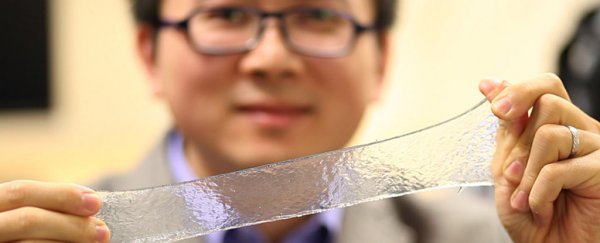Human beings have been dressing wounds with various kinds of bandages for thousands of years, but it's unlikely an injured person ever wore a Band-Aid quite like this.
Researchers in the US have developed a sticky, stretchable gel-like material that can be used as a "smart wound dressing". Incorporating temperature sensors and drug reservoirs, the hydrogel bandage can release medicine in response to changes in skin temperature, and embedded LEDs even light up to let you know when your meds are running low.
"Electronics are usually hard and dry, but the human body is soft and wet. These two systems have drastically different properties," said Xuanhe Zhao, a mechanical engineer at the Massachusetts Institute of Technology (MIT).
"If you want to put electronics in close contact with the human body for applications such as health care monitoring and drug delivery, it is highly desirable to make the electronic devices soft and stretchable to fit the environment of the human body. That's the motivation for stretchable hydrogel electronics."
The hydrogel matrix that makes up the dressing has numerous advantages over conventional cloth-based bandages. It's highly flexible and stretches easily so can be applied to any area of the body, including joints like elbows or knees.
The rubbery material is mostly composed of water and can be embedded with a range of electronics such as conductive wires, semiconductor chips, LED lights, and temperature sensors.
Describing the dressing in Advanced Materials, the researchers say their bandage can deliver different drugs to different segments of skin in relation to their respective temperature, with medication flowing through pathways in the gel created via tube insertions or drilled holes.
"It's a very versatile matrix," said one of the team, Hyunwoo Yuk. "The unique capability here is, when a sensor senses something different like an abnormal increase in temperature, the device can on demand release drugs to that specific location and select a specific drug from one of the reservoirs, which can diffuse in the hydrogel matrix for sustained release over time."
The hydrogel would prove an efficient salve for things like burns and skin conditions, but according to the researchers, it's not limited to external use, and could even theoretically be used inside the body to house implanted electronics, such as glucose sensors or neural probes.
"The brain is a bowl of Jell-O," said Zhao. "Currently, researchers are trying different soft materials to achieve long-term biocompatibility of neural devices. With collaborators, we are proposing to use robust hydrogel as an ideal material for neural devices, because the hydrogel can be designed to possess similar mechanical and physiological properties as the brain."
